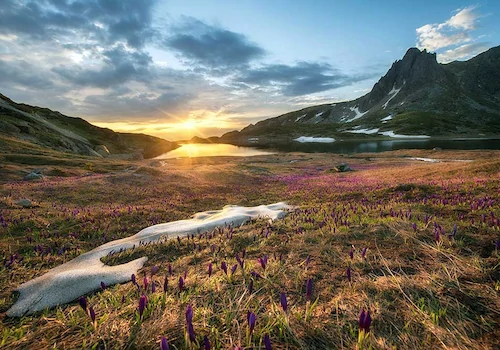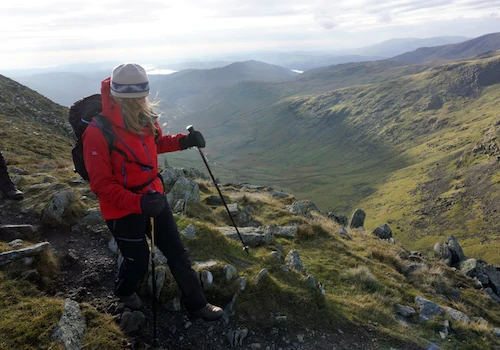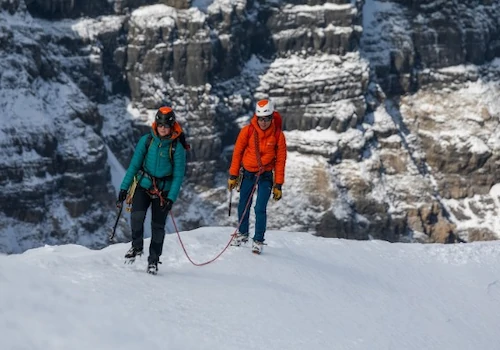
- Expeditions
By Region
By Month
By Grade
By Height

- Treks
- UK & Alpine
- Schools
- Hire
- News
- Shop
Comparing Trekking Peaks in Nepal
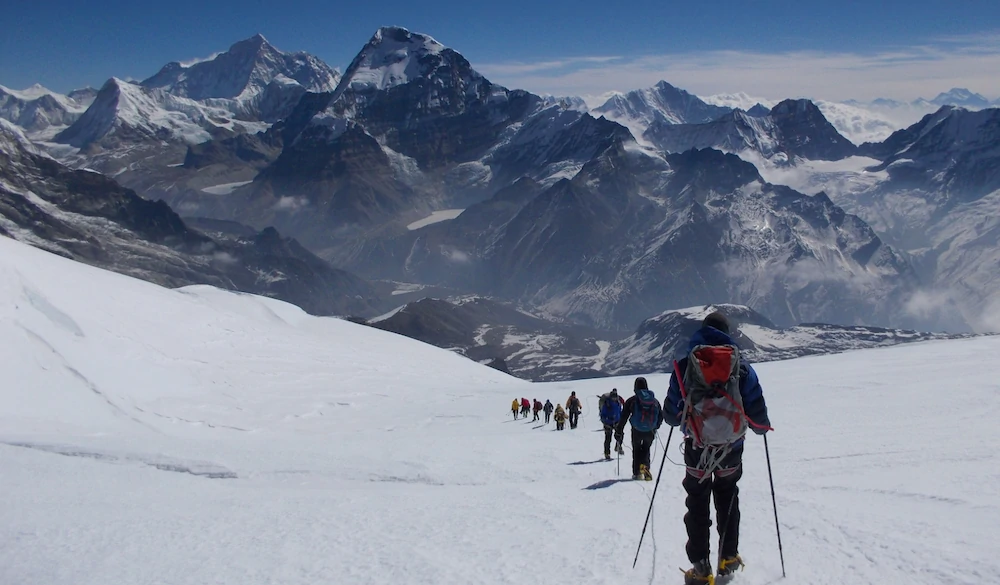
What is a Trekking Peak?
In Nepal, a trekking peak is a mountain peak that ranges from 5,650 meters to 6,500 meters in height and has been designated as a "trekking peak" by the Nepal Mountaineering Association (NMA). These peaks are considered to be relatively easier to climb compared to the higher mountains in the region, such as the 8,000-meter peaks like Everest and Manaslu.
Climbing a Nepali trekking peak does not require technical climbing skills, but you should have basic mountaineering skills like being able to use ice axe, crampons and know how to abseil. Ideally you should have some prior mountaineering experience. It also requires a good level of fitness.
Adventure Peaks operates some of the popular Nepali trekking peaks, which include Island Peak (6,189m), Mera Peak (6,476m), Lobuche East (6,119m), and Kyajo Ri (6,186m). These peaks offer a great opportunity for climbers to experience mountaineering and climbing in a high-altitude setting while enjoying the stunning scenery of the Himalayas.
Peak Comparison
Nestled in the heart of the Nepali Himalayas, Mera Peak, Island Peak, Lobuche East, and Kyajo Ri are some of the most popular trekking peaks in the region. Each peak offers its own unique set of challenges, rewards, and experiences for adventurous climbers. Let's compare the four peaks and explore what makes them stand out.
Mera Peak (6476m)
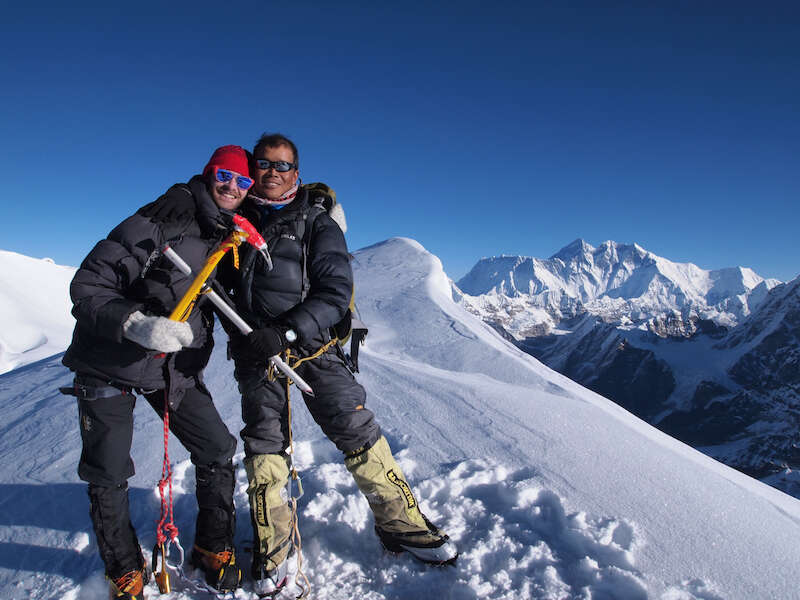 Standing at 6,476 meters Mera Peak, is the highest of the Trekking peaks and is known for its sweeping views of the surrounding Himalayan ranges. On a clear day it’s possible to see five 8000m peaks. The climb is a challenging trek that involves glacier crossings and a short section of fixed line. It's a great choice for experienced winter trekkers who want a more remote and adventurous climb.
Standing at 6,476 meters Mera Peak, is the highest of the Trekking peaks and is known for its sweeping views of the surrounding Himalayan ranges. On a clear day it’s possible to see five 8000m peaks. The climb is a challenging trek that involves glacier crossings and a short section of fixed line. It's a great choice for experienced winter trekkers who want a more remote and adventurous climb.
The base camp for Mera Peak is located on the Mera La at around 5400m. The High Camp is situated at 5800m.
The summit day starts early in the morning, around 1-2 am. After reaching the summit you will descend all the way down to base camp, have lunch and then continue either down to Khare, if only climbing Mera Peak, or down to Kongma Dingma, if continuing on to Island Peak.
The ascent from High Camp involves roped travel on easy angled snow slopes. There is a final approach onto the summit does steepen up, but only for a short distance.
Summit views: Once at the summit, climbers are rewarded with stunning views of the Himalayan giants of : Cho Oyu, Everest, Lhotse, Makalu & Kanchajunga.
Island Peak (6189m)
 Also known as Imja Tse, Island Peak is a popular peak in the Khumbu region of Nepal. The climb involves a mix of rock, ice, and snow with some exposure, and requires some basic mountaineering skills including abseiling. Island Peak is a great choice for climbers who want a challenging but accessible climb.It is possible to use the high camp, in order to reduce the length of the summit day, but water has to be carried up to the camp, as there is no water source. The summit day of Island Peak usually starts early in the morning, around 1-2 am. After reaching the summit you will descend all the way down to base camp.
Also known as Imja Tse, Island Peak is a popular peak in the Khumbu region of Nepal. The climb involves a mix of rock, ice, and snow with some exposure, and requires some basic mountaineering skills including abseiling. Island Peak is a great choice for climbers who want a challenging but accessible climb.It is possible to use the high camp, in order to reduce the length of the summit day, but water has to be carried up to the camp, as there is no water source. The summit day of Island Peak usually starts early in the morning, around 1-2 am. After reaching the summit you will descend all the way down to base camp.
The first part of the climb involves ascending a steep trail to the base of the glacier. The trail can be rocky and slippery in some places, so climbers need to be careful.
Once at the base of the glacier, climbers need to rope up, put on crampons and carry ice axes. Climbers follow a well-defined route. The climb involves ascending steep snow and ice slopes, with occasional crevasses that need to be negotiated.
The final part of the climb involves a steep (up to 50 degrees) push to the summit. This section can be quite demanding, and climbers need to be physically and mentally prepared to handle the altitude and the steep terrain.
Summit views: Once at the summit, climbers are rewarded with stunning views of the surrounding peaks, including Ama Dablam, Lhotse, and Everest.
Lobuche East (6119m)
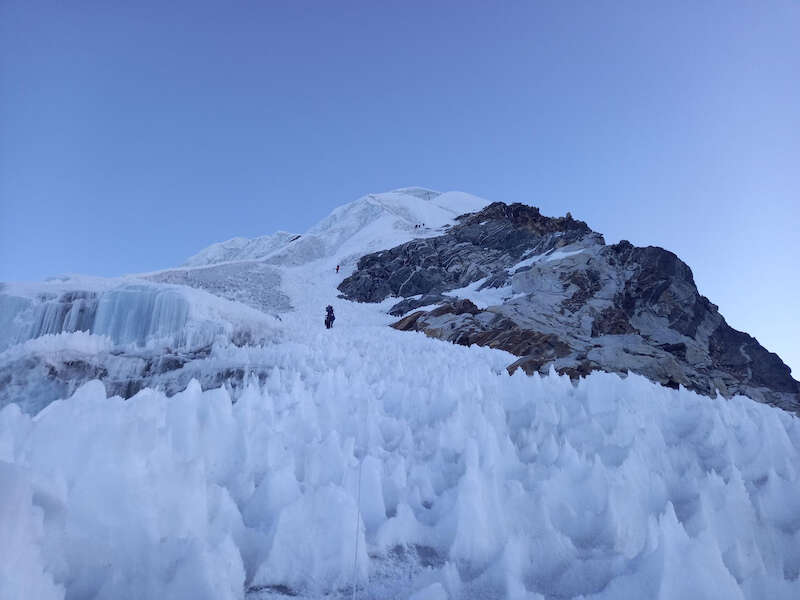 The lowest of the trekking peaks Adventure Peaks offers, is a popular peak in the Khumbu region of Nepal. The climb involves a mix of rock, ice, and snow, and requires basic mountaineering skills including abseiling. The peak is known for its stunning views of the Khumbu region, looking across to Everest, Lhotse & Nuptse. It is a great choice for climbers who want a challenging climb with breath taking views.
The lowest of the trekking peaks Adventure Peaks offers, is a popular peak in the Khumbu region of Nepal. The climb involves a mix of rock, ice, and snow, and requires basic mountaineering skills including abseiling. The peak is known for its stunning views of the Khumbu region, looking across to Everest, Lhotse & Nuptse. It is a great choice for climbers who want a challenging climb with breath taking views.
Adventure Peaks combines this peak with a trek to Gokyo Lakes and Everest Base Camp. Ascending over the Cho La pass from Gokyo, you will eventually make your way to Lobuche village. From Lobuche village climbers ascend to the High Camp at 5200m in readiness to make their summit bid early the next morning.
The summit day starts around 1-2 am. From the camp the route works it's way up the large rocky slabs to the start of the glacier and crampon point. The majority of the glacier is at an angle of around 45 degrees, with the odd section of 50 degrees. After reaching the summit you will descend back to High Camp for lunch and then continue on down back to Lobuche village.
Summit views: Once at the summit, climbers are rewarded with stunning views of the surrounding peaks, including Everest, Lhotse, Nuptse, Ama Dablam, and many others.
Kyajo Ri (6186m)
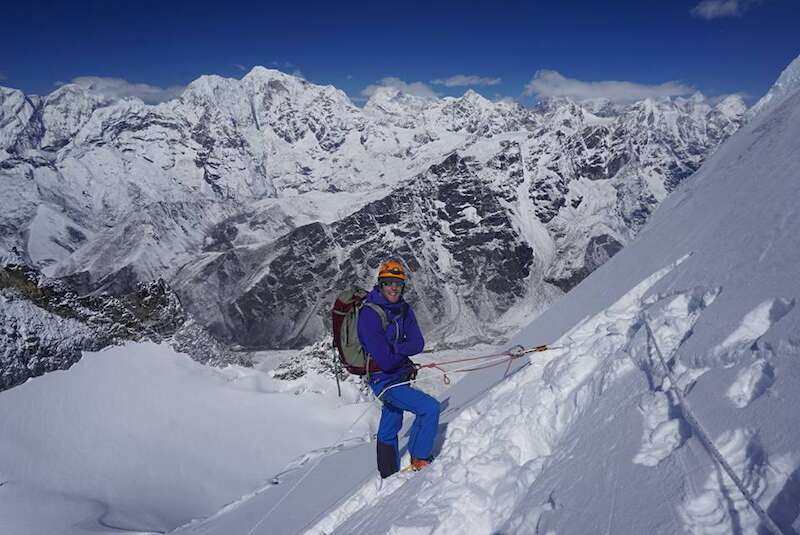 Kyajo Ri is the hardest of the Trekking peaks Adventure Peaks offers. A remote and less-visited peak that provides a more adventurous climbing experience. The climb involves a mix of rock, ice, and snow, and requires advanced mountaineering skills, due to the steeper terrain. The peak is known for its stunning views of the surrounding valleys and is a great choice for experienced climbers who want a more challenging and remote climb.
Kyajo Ri is the hardest of the Trekking peaks Adventure Peaks offers. A remote and less-visited peak that provides a more adventurous climbing experience. The climb involves a mix of rock, ice, and snow, and requires advanced mountaineering skills, due to the steeper terrain. The peak is known for its stunning views of the surrounding valleys and is a great choice for experienced climbers who want a more challenging and remote climb.
There are two camps above base camp for Kyajo Ri. Glacier Camp and South Col Camp. The High Camp is actually located in the couloir just below the South Col.
The summit day starts early in the morning, around 1-2 am. After reaching the summit you will descend all the way down to base camp.
The ascent from High Camp involves moving on fixed lines on steep mixed terrain, rocky slabs and snow slopes.
Summit views: Once at the summit, climbers are rewarded with stunning views of the Himalayan giants of : Cho Oyu, Everest, Lhotse & Makalu.
In terms of logistics, all four peaks require a similar level of preparation and equipment. Time is built into the programmes for acclimatisation enroute, before attempting the climb.
Mera Peak, Island Peak, Lobuche East, and Kyajo Ri are four stunning trekking peaks that offer their own unique set of challenges and rewards. Whether you're seeking a remote and adventurous climb or a more accessible and popular peak, there's a trekking peak in Nepal that's right for you.

About Stu Peacock
Stu Peacock is a very experienced high altitude mountaineer who has been to the Summit of Everest, Broad Peak, Cho Oyu, Manaslu and climbed on K2. His other expeditions include: Ama Dablam, Annapurna IV, Peak Lenin, Aconcagua, Khan Tengri, Tien Shan Unclimbed, Korzhenevskaya, Himlung Himal, Baruntse, Mera & Island Peak, Alpamayo, Bolivian Peaks, Spantik, Carstensz Pyramid, Elbrus, MtArarat, Mexican Volcanoes, Mt Kenya and Kilimanjaro. He was the first Brit to summit Everest via the North Ridge 3 times and has climbed Everest from both the North & South sides.

